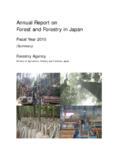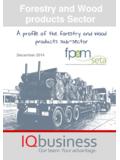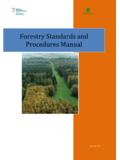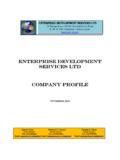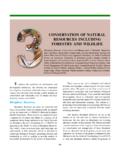Transcription of Trees and shrubs of the Maldives - Food and Agriculture ...
1 Trees and shrubs of the Regional Office forAsia and the PacificBangkok, ThailandMinistry of fisheries , Agricultureand Marine ResourcesMaldivesRAP Publication No. 2007/12 The designations employed and the presentation of the material in thispublication do not imply the expression of any opinion whatsoever onthe part of the Food and Agriculture Organization of the United Nationsconcerning the legal status of any country, territory, city or area or of itsauthorities, or concerning the delimitation of its frontiers or opinions expressed in this publication are those of the author aloneand do not imply any opinion whatsoever on the part of edition: 2007 ISBN: 978-974-7946-94-9 FAO Regional Office for Asia and the PacificPrinted by Thammada Press Co.,Ltd., BangkokFor copies of the book, write to:Patrick B. DurstSenior Forestry OfficerFAO Regional Office for Asia and the Pacific39, Phra Atit RoadBangkok 10200 ThailandTel: (66-2) 697 4000 Fax: (66-2) 697 4445 Email: vi1 Introduction.
2 Maldives .. 12 How to use this book .. this book is organized .. terms relevant foridentification of Trees and shrubs .. 83 Broadleaved Trees and 154 Mangrove Trees and shrubs .. 1775 Palm Trees .. 2076 Pandanus Trees and shrubs .. 2187 Narrow leaved tree - Casuarina .. 2238 References, further readings andimportant websites .. 2269 Index of scientific and common names .. 23010 Index of Dhivehi names .. 238 ForewordThe Maldives is endowed with blue seas, green forests and rich island vegetationof which every Maldivian is proud. These forests and Trees are used by theislanders primarily as a source of timber but also for medicinal and culinarypurposes amongst many others. For their effective conservation and sustainablemanagement it is essential for relevant information on the identity, ecology anduse of each species to be catalogued and disseminated.
3 The Forestry programmefor early rehabilitation in Asian tsunami effected countries , which is supportedby the Government of Finland and coordinated by the FAO Regional Office forAsia and the Pacific, took the initiative to publish this important book and weare sure it will be welcomed and used both by the people and residents ofMaldives and by the many visitors the country receives each FAO Regional Office for Asia and the Pacific with funding from theGovernment of Finland, are particularly proud to have played a role in supportingproduction of this book and, more widely, to have provided support for theadvancement of forestry and conservation in the Maldives . Recognition of thevalues of Trees and forests and the environment is climbing the global agendaand through this publication we hope that awareness will be raised amongstMaldivians and others interested in studying the wide range of Trees and shrubspresent in this picturesque group of would like to thank the author , Dr.
4 Selvam Vaithilingam, for his meticulousand hard work and Dr. Ravishankar Thupalli, Chief Technical Advisor of theMaldivian component of the FAO Forestry tsunami programme, for his guidanceand assistance in bringing this important book into being. Thanks are also dueto Mr. Abdul Majeedh Mahir, Mr. Mohamed Naseem and Mr. Hussain Faisalof the Ministry of fisheries , Agriculture and Marine Resources for work is the first of its kind in Maldives and contains information on 100species including broadleaves, mangroves, pandanus, palms and believe this book, with its abundant and colorful pictures, will serve as astimulus for Maldivian people and conservationists alike and will further promotethe propagation and conservation of Forests and Trees for a Green Maldives .He ChangchuiAbdhullah KamaludeenAssistant Director-General andMinister for fisheries , AgricultureRegional Representative for Asia and the Pacificand Marine ResourcesFood and Agriculture Organization ofGovernment of Maldivesthe United NationsvTrees and shrubs of the MaldivesviAcknowledgementsThe author wishes to express his sincere thanks to Mr.
5 AbdullahKamaludeen, Honourable Minister, Mr. Mohamed Zuhair, DeputyMinister, Mr. Mohamed Naseem, Ms. Michelle Ahmed and Mr. HussainFaisal, all of the Ministry of fisheries , Agriculture and Marine Resourcesof the Maldives for lending their experience, knowledge and generalsupport in preparing the book. Thanks are given to Mr. Mahir for assistancein collecting information on the traditional uses of plants listed in thebook and to Mr. Mohamed Abubakuru and other staff of the AgricultureResearch Centre, Hanimadhoo for hosting visits of the author. Thanksare also due to Mr. Nabeel and Mr. Ali Nishaman for assistance incollecting literature and field publication would not have been possible without the contributionsof the Chiefs of atolls and islands visited during data collection and thecommunity members who readily and generously shared their knowledgeand experience relating to the sustainable utilization of the forest resourcesof the author also thanks Dr.
6 Ravishankar Thupalli, Chief Technical Advisorfor the Maldives component of the Forestry Programme for EarlyRehabilitation in Asian Tsunami Affected Countries (OSRO/GLO/502/FIN), for extending advice and support during the planning andpreparation of this book. Ms. Susan Braatz and Mr. Jeremy Broadhead ofFAO Regional Office for Asia and the Pacific provided guidance andediting of inputs, and Mr. Winston Rudder and Fernandez Larrinoaof FAO, Maldives gave support throughout the preparation Simmathiri Appanah and Mr. M. Kashio of FAO Regional Officefor Asia and the Pacific, and Mr. Oudara Souvannavong andMr. Jim Carle of FAO Headquarters, Rome are acknowledged for reviewingand commenting on the manuscript. Dr. Narasimhan Duvuru, MadrasChristian College, Chennai and Dr. Rao, Botanical Survey ofIndia are also thanked for their review of the are given to Dr.
7 M. S. Swaminathan, Chairman, Dr. M. Velayutham,Executive Director at the M. S. Swaminathan Research Foundation,Chennai, India for extending their full , gratitude is owed to the Government of Finland for providing thenecessary funding support through the Forestry Programme for EarlyRehabilitation in Asian Tsunami Affected Countries (OSRO/GLO/502/FIN).viTrees and shrubs of the MaldivesviiTrees and shrubs of the MaldivesviiiTrees and shrubs of the MaldivesIntroductionThe human race depends on forests, Trees and other vegetation for itssurvival and well-being. Women, men and children are attracted andattached to Trees , shrubs , herbs and other vegetation for various reasonsand purposes. Some Trees are culturally valuable and some others areimportant in terms of social norms and beliefs as well as traditionalsystems but many of them are essential to satisfy basic human needs suchas food, shelter, clothing and employment.
8 They also play an importantrole in safeguarding environmental integrity. In an atoll environmentlike the Maldives , they are also important for reasons such as stabilizationof sand and protection against salt spray. Trees and shrubs also play acritical role in reducing the impact of natural calamities, such as tidalwaves and tsunamis on human lives and properties (Danielsen et al.,2005; Selvam, 2005).As in many small islands, vegetation in the Maldives has changed bothquantitatively and qualitatively over time due to overexploitation byincreasing human populations, unsound land use practices, poor landtenure policies and intentional and unintentional introduction of exoticsand commercial species (Wills and Gardiner, 1901; Zuhair, 1997). Suchchanges have made the islands of the Maldives , their ecosystems andhuman populations more vulnerable to natural calamities such ascyclones, tidal waves and tsunami and man-made calamities such asrising sea these facts into consideration, this book on Trees and shrubs ofthe Maldives aims to improve awareness of the Trees and shrubs of theMaldives and their ecological importance; provide an overview of theirlocal uses and potential role in increasing the economic security ofMaldivian communities; and outline propagation and managementtechniques for their MaldivesGeographyThe Maldives is a large archipelago of 1190 coral islands, spreading over860 km in a north-south direction in the Indian Ocean and covering anarea of 90,000 sq km.
9 Only 202 of these islands are inhabited. The islandsare grouped into 26 natural atolls and 19 atolls for administrativepurposes (Fig. 1). These atolls are situated atop a 1600 km long underseamountain range called as Laccadive-Chagos Ridge, which extends intothe Central Indian Ocean from the south-west coast of the Indiansubcontinent. Most of the atolls consist of a ring-shaped live coral reefsupporting numerous islands. Most of the islands are small and vary insize between and 5 sq km. They are flat and without hills or 80% of the land area is less than 1 m above mean high tide level(MHAHE, 1999).ClimateThe climate of the Maldives is equatorial, warm and humid with twopronounced monsoon seasons, the south-west and the north-east monsoonseasons. The temperature is fairly constant throughout the year with amean annual temperature of 28oC. The average summer temperatureranges between and and winter temperature between 30oC.
10 The diurnal variation is very small, rarely exceeding 6oC. Aprilis the hottest month with an average temperature of and October isthe coolest with an average of 25oC. Relative humidity is high throughoutthe year, ranging from 73 to 85%.The annual average rainfall in Maldives is 1890 mm. The rainfall in thesouthern atolls is greater with an annual average of 3050 mm, whereas itis only 1520 mm in the northern atolls. The south-west monsoon, whichextends from the end of April to the end of September, brings heavy rain tothe entire archipelago. The rainfall decreases considerably during thenorth-east monsoon season that prevails from December to March andduring this season periods of drought may be experienced, particularlyin the northern group of islands. However, the weather patterns of theMaldives do not always confirm to the monsoon patterns of South example, heavy rain over the whole country has been known to occurcontinuously for up to one week even during the midst of the dry Maldives is outside the main area of tropical cyclones and thereforegales are uncommon and cyclones are very rare.










